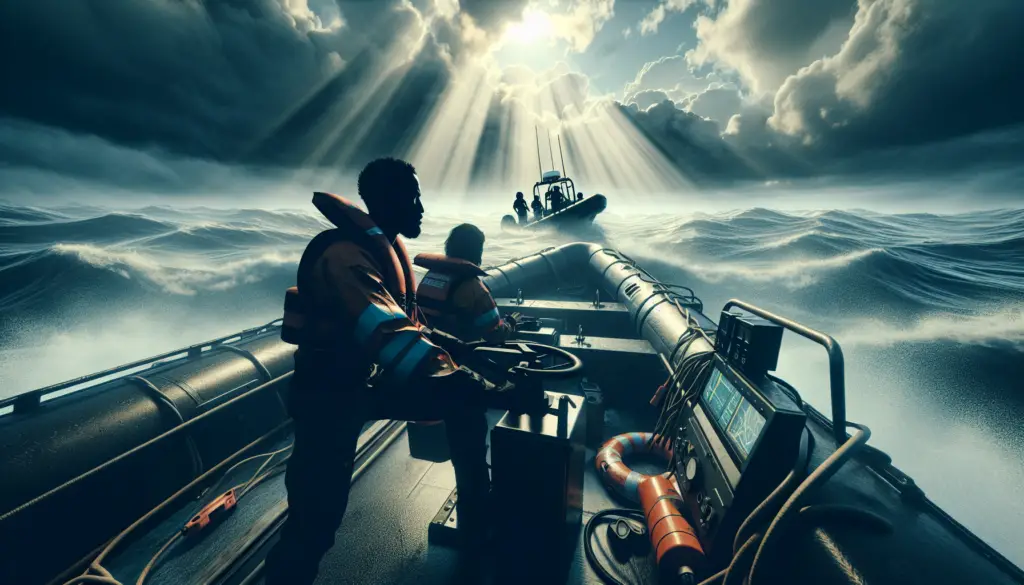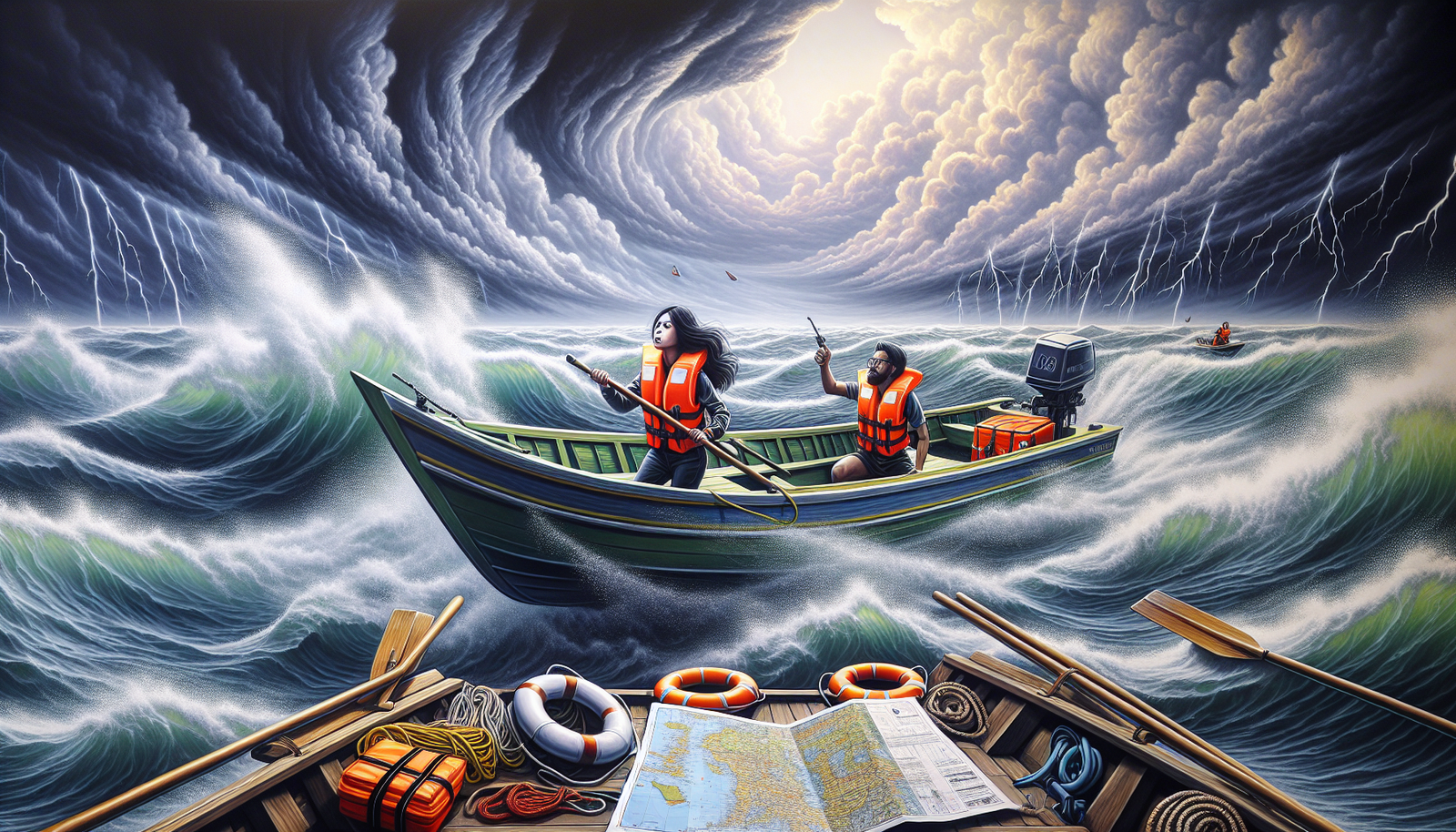Imagine the rush of waves crashing against your boat as you navigate the tempestuous seas. It’s both an exhilarating and daunting experience and one where safety precautions cannot be compromised. “Top Safety Precautions When Boating In Rough Waters” paints a vivid portrait of this adrenaline-pumping journey, while equipping you with crucial knowledge and procedures to maintain your safety. This piece will guide you through the rough tides and turbulent winds, ensuring that you’re not just surviving the tempest, but mastering it.

Understanding Weather Conditions
Out on the water, you’re at the mercy of the elements. Thus, understanding weather conditions is a crucial skill if you’re taking up boating. More so, if you’re venturing out in rough waters. Equipping yourself with this knowledge could be the difference between a serene voyage and a dire struggle.
Knowing the forecast
Before setting sail, always remember to know your weather forecast. Checking the updated marine forecast by trusted weather forecasting sources is a task you should never overlook. These updates would give you insights into wind direction and speed, wave heights, weather fronts, and changes that could affect your boating trip.
Recognizing telltale signs of changing weather
Aside from relying on the weather forecast, you should also be able to spot changes in the weather firsthand. This means observing the sky, feeling the wind direction, looking at the waves, and sensing shifts in temperature. These are all clues that can help you anticipate what’s coming and plan accordingly.
Using weather apps and instruments
Additionally, technology is also on your side. Leverage weather apps and instruments such as barometers, thermometers, and anemometers to make comprehending weather conditions even easier. These tools can provide you with real-time weather updates and keep you ahead of sudden changes.
Proper Boat Maintenance
Routine, comprehensive boat maintenance can not only mitigate the risk of sudden breakdowns but also ensure that your boat is equipped to take on rough waters.
Checking the engine and fuel systems
Regularly run a thorough check of your engine and fuel systems. Look for any signs of damage, leaks, or wear and tear. Ensure that your fuel gauge is working correctly and that there’s ample fuel for your trip.
Inspecting the hull for leaks
The hull is the core of your boat’s buoyancy. Regularly inspect the hull for leaks or damage. If you’re fishing in rough waters, the integrity of your hull is not something you want to compromise on.
Ensuring navigational lights work
Navigational lights are essential to alert other boaters of your presence, especially during night-time or in poor visibility conditions. Make sure they’re functioning properly — it’s a matter of safety.

Mastering Navigation Skills
Being able to navigate your boat accurately indicates that you are competent at commanding your vessel. It could mean all the difference when you’re out in tough seas.
Understanding navigational markings and signs
Navigational markings and signs are akin to the road signs on highways. They direct you where to go and warn you about danger zones. Understanding these signs is a prerequisite to safe and effective boating.
Using GPS and RADAR effectively
GPS and RADAR systems are your best friends when it comes to maritime navigation. They provide valuable data about your position, course, and surrounding obstacles. Make an effort to learn how to use them effectively.
Plotting a course in challenging conditions
Plotting a course is one of the most critical components of your voyage planning. It is particularly crucial in rough seas, as struggling weather might necessitate modifications to your preplanned route. Hence, always be prepared to adapt.
Having Appropriate Safety Gear
Onboard safety gear is a life-saving investment. Whether it’s calm water or challenging seas, always be prepared for unforeseen circumstances.
Using life jackets and PFDs
Life jackets and personal flotation devices (PFDs) can be the difference between life and death in a man-overboard scenario. Make sure you and your passengers are wearing them at all times.
Having a throwable flotation device
In addition to life jackets, have a throwable flotation device on board. This piece of equipment can be thrown to a person who has accidentally fallen into the water, providing an extra form of protection.
Investing in a reliable marine radio
A marine radio is an integral part of your boating safety gear. It can facilitate communication with the coastal guard or other boaters during distress situations. Investing in a trustworthy radio would not be a decision you’d regret.

Understanding Your Boat’s Limitations
Every boat, no matter how robust or advanced, has limitations. Understanding those is a must when facing challenging seas.
Knowing your boat’s wave height limits
Knowing your boat’s wave handling capabilities in advance can prevent dangerous situations. Each boat responds differently to various wave heights. Use your manufacturer’s guidelines and personal experience to guide you.
Understanding lateral stability
Lateral stability is an important factor to consider when dealing with rough water. Recognize your boat’s tipping point and know what to do when the boat starts listing to one side.
Gauging your boat’s load capacity
Every boat has a maximum capacity limit for both passengers and equipment. Never exceed these limits, as overloading can affect the boat’s stability and performance in rough seas.
Developing a Float Plan
A float plan keeps others informed about your whereabouts, increasing the chances of your safety.
Communicating your intended route
Let someone responsible onshore know your intended route. This way, they’ll know where to look if you don’t return at the expected time.
Signaling your expected return
Also, share your expected return time. This would serve as an alarm in case you’re late and possibly in distress.
Sharing your plan with responsible individuals
Anybody who knows about your voyage can alert authorities if necessary. So, in addition to the coast guard, tell others about your float plan as well.

Practicing Man Overboard Procedure
No one plans to have an overboard situation, but it always helps to be prepared.
Learning quick-stop method
The quick stop method is designed to recover a person overboard with the least amount of delay. Learn it well – it enhances your chances of retrieving a man overboard in tough water conditions.
Understanding the reach, throw, row, go principle
The ‘reach, throw, row, go’ principle outlines four steps to take when rescuing people in the water. Make it second nature as it could save a life someday.
Conducting regular practice drills
To embed the man overboard procedure into your subconscious mind, hold regular practice drills. Real-life situations involve pressure and adrenaline, and the drills would help you act wisely.
Operating the Boat Safely
Safe boat handling is like a boating hymn – to be practiced on every trip, regardless of water conditions.
Having a designated lookout
Always have a designated lookout aboard, especially in challenging seas. They can warn you about approaching vessels, floating debris, struggling weather, or anything out of the ordinary.
Maintaining a safe speed
Maintain a safe speed that corresponds with surrounding conditions. Rough water requires you to slow down to reduce the impact of waves on your boat.
Avoiding alcohol while boating
It’s always a bad idea to mix alcohol with boating. Alcohol can unfavorably affect your judgement, balance, and coordination. Thus, promote a ‘no alcohol on board’ policy.
Utilizing Emergency Signals
Emergency signals are a must-know for all boaters.
Employing visual distress signals
Visual distress signals-like flares, flags, or lights-are used to attract attention in case of an emergency. Familiarize yourself with their usage.
Understanding proper use of sound signals
Sound signals, like whistles or air horns, are intended to alert other boats to your presence, particularly in foggy conditions or at night. Master the correct use of these signals.
Knowing how and when to fire flares
Firing flares is an internationally recognized distress signal. They’re most effective at night or during low visibility conditions as they shoot up in the sky and burn brightly. Reflect on the proper use and opportune times for firing flares.
Taking a Boating Safety Course
A boating safety course acts like an anchor in the seas of knowledge.
Learning from experienced instructors
Experienced instructors could provide anecdotes of their experiences, discuss case studies, and deliver hands-on training. These insights would allow you to deal with challenging situations confidently.
Receiving certification from reputable organizations
Certification implies that you’ve learned, understood, and exhibited the important aspects of boat handling and maintenance, and safety practices. It’s a stamp of guarantee that increases your credibility.
Staying updated with the latest safety guidelines
Safety guidelines are ever-evolving. They improve with each untoward incident to prevent its recurrence. Hence, stay updated with the latest safety guidelines to keep yourself on the safer cruise.
So, there you have it — some of the top safety precautions that you should take when boating in rough waters. Boating is a thrilling activity. Let’s keep it that way by ensuring the utmost safety and preparedness. Happy and safe boating!

